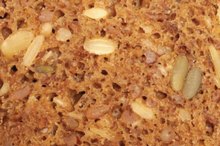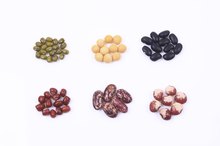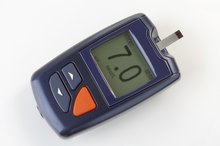What does fact checked mean?
At Healthfully, we strive to deliver objective content that is accurate and up-to-date. Our team periodically reviews articles in order to ensure content quality. The sources cited below consist of evidence from peer-reviewed journals, prominent medical organizations, academic associations, and government data.
The information contained on this site is for informational purposes only, and should not be used as a substitute for the advice of a professional health care provider. Please check with the appropriate physician regarding health questions and concerns. Although we strive to deliver accurate and up-to-date information, no guarantee to that effect is made.
Rice and Potatoes on the Glycemic Index
Rice and potatoes are rich in starches, and both of these foods can cause a marked increase in your blood sugar levels. But you don’t have to eliminate them from your diet to maintain stable blood sugar levels, according to the Glycemic Index Foundation 1. Instead, combine these starchy foods with those that have a low glycemic index value to minimize their negative effects 1.
Glycemic Index Values
The glycemic index ranks the effects of a food that contains carbohydrates on your blood glucose levels. Foods that elevate blood sugar quickly and significantly rank higher on a scale of 1 to 100 than foods that have a low to moderate effect. Foods that score higher than a 55 are considered high-glycemic index; anything less than a 55 is considered low-glycemic index according to the Glycemic Index Foundation 1. The type of rice and the cooking method may cause some variation in index values. Boiled white rice has a value ranging from the 70s to high 80s. Boiled brown rice has a value ranging from the high 60s to the high 80s. A baked potato has a value ranging from 78 to 111, while a boiled potato has a value of 89.
- The glycemic index ranks the effects of a food that contains carbohydrates on your blood glucose levels.
- Boiled brown rice has a value ranging from the high 60s to the high 80s.
Carbohydrate Content
Low-Glycemic Foods List
Learn More
The starches in rice and potatoes are complex carbohydrates, which your body breaks down into glucose -- a form of sugar that is the primary source of fuel for your muscles and vital organs. Your body breaks down the starches in rice and potatoes very quickly, resulting in a more rapid increase in the level of glucose in your bloodstream. The longer you cook a starchy food like potatoes and rice, the more gelatinized the starch becomes, which raises its glycemic index value, according to the UMass Memorial Medical Center 2. The type of starch in a food can also affect its glycemic index value. Basmati rice is high in amylose, which has a less significant effect on blood sugar than amylopectin, another form of starch found in rice. The value of basmati rice is only 57, which makes it a moderate-glycemic index food.
- The starches in rice and potatoes are complex carbohydrates, which your body breaks down into glucose -- a form of sugar that is the primary source of fuel for your muscles and vital organs.
- Basmati rice is high in amylose, which has a less significant effect on blood sugar than amylopectin, another form of starch found in rice.
Glycemic Load
The glycemic load combines the glycemic index value of a food with the amount of carbohydrates in that food to determine that food’s glycemic potency. A 150-g, or 1.5-cup, serving of boiled white rice has a glycemic index value of 83, 36 g of carbohydrate per serving and a glycemic load of 30. A 150-g serving of boiled red potatoes has a glycemic index value of 89, 21 g of carbohydrate per serving and a glycemic load of 19. Because rice and potatoes are high in carbohydrates that have a significant effect on blood sugar, they have a high glycemic load, as well as a high glycemic index. By comparison, a 120-g apple has a glycemic index value of 34, 16 g of carbohydrate per serving and a glycemic load of 5. The apple has few carbohydrates relative to its volume, and these carbohydrates have a low effect on blood glucose levels. That results in a low glycemic load.
- The glycemic load combines the glycemic index value of a food with the amount of carbohydrates in that food to determine that food’s glycemic potency.
- A 150-g serving of boiled red potatoes has a glycemic index value of 89, 21 g of carbohydrate per serving and a glycemic load of 19.
Meal Planning
Glycemic Load Food List
Learn More
If you’re using the glycemic index value of foods to fine-tune the carbohydrate content in your meals, serve moderate portions of rice or potatoes with foods that have a low glycemic index value 1. The glycemic effects of a low-glycemic index food can balance out the effects of a food with a higher index number. Foods that contain mostly protein and fat, such as meat, poultry and eggs, have no notable effect on blood sugar. Vegetables such as broccoli or lettuce have such low amounts of digestible carbohydrate that their glycemic index level can’t be evaluated. Foods that are high in soluble fiber, a viscous form of fiber that delays your body’s conversion of carbohydrates into glucose, also have a low glycemic index number 1. Foods high in soluble fiber include legumes and oats. The Glycemic Index Foundation recommends that you eat at least one low-glycemic index food per meal to maintain stable blood sugar levels 1.
Related Articles
References
- Glycemic Index Foundation: GI Foods Search
- UMass Memorial Medical Center: Diabetes and the Glycemic Index
- Ojo O, Ojo OO, Adebowale F, Wang XH. The effect of dietary glycaemic index on glycaemia in patients with type 2 diabetes: A systematic review and meta-analysis of randomized controlled trials. Nutrients. 2018;10(3):373. Published 2018 Mar 19. doi:10.3390/nu10030373
- Glycemic Index and Diabetes. American Diabetes Association
- Search for the Glycemic Index. The University of Sydney
- Zeevi D, Korem T, Zmora N, et al. Personalized Nutrition by Prediction of Glycemic Responses. Cell. 2015;163(5):1079-1094. doi:10.1016/j.cell.2015.11.001+
- Sacks FM, Carey VJ, Anderson CA, et al. Effects of high vs low glycemic index of dietary carbohydrate on cardiovascular disease risk factors and insulin sensitivity: the OmniCarb randomized clinical trial. JAMA. 2014;312(23):2531-41. doi:10.1001/jama.2014.16658.
- Vega-lópez S, Venn BJ, Slavin JL. Relevance of the Glycemic Index and Glycemic Load for Body Weight, Diabetes, and Cardiovascular Disease. Nutrients. 2018;10(10). doi:10.3390/nu10101361
- Glycemic Index Database. University of Sydney. Updated October 13, 2020
- Eleazu C. O. (2016). The concept of low glycemic index and glycemic load foods as panacea for type 2 diabetes mellitus; prospects, challenges and solutions. African health sciences, 16(2), 468–479. doi:10.4314/ahs.v16i2.15
- Foster-Powell, Kaye, Holt, Susanna and Brand-Miller, Janette. "International table of glycemic index and glycemic load values: 2002." American Journal of Clinical Nutrition. 76,:1: 5-56 (2002).
- International Carbohydrate Quality Consortium, Jenkins, D. J., Willett, W. C., Astrup, A., Augustin, L. S., Baer-Sinnott, S., … Wolever, T. M. (2014). Glycaemic index: did Health Canada get it wrong? Position from the International Carbohydrate Quality Consortium (ICQC). The British journal of nutrition, 111(2), 380–382. doi:10.1017/S0007114513003905
- Leroux, MarcusFoster-Powell, Kaye, Holt, Susanna and Brand-Miller, Janette. "International Table of Glycemic Index and Glycemic Load Values: 2002." American Journal of Clinical Nutrition. Vol. 76, No. 1, 5-56, (2002).
- Lui, S., Willett, WC, et al. "A prospective study of dietary glycemic load, carbohydrate intake, and risk of coronary heart disease in US women.." American Journal of Clinical Nutrition. 71(6):1455-61. (2001).
- Mayer-Davis, E.J., Dhawan, A et al. "Towards understanding of glycaemic index and glycaemic load in habitual diet: associations with measures of glycaemia in the Insulin Resistance Atherosclerosis Study.." British Nutrition Journal. 95(2):397-405. (2006).
- Sacks, F. M., Carey, V. J., Anderson, C. A., Miller, E. R., 3rd, Copeland, T., Charleston, J., … Appel, L. J. (2014). Effects of high vs low glycemic index of dietary carbohydrate on cardiovascular disease risk factors and insulin sensitivity: the OmniCarb randomized clinical trial. JAMA, 312(23), 2531–2541. doi:10.1001/jama.2014.16658
- Salmeron, J, Manson, JE, et al. "Dietary fiber, glycemic load, and risk of non-insulin-dependent diabetes mellitus in women.." Journal of the American Medical Association. 12;277(6):472-7. (1997).
- Vega-López, S., Venn, B., & Slavin, J. (2018). Relevance of the Glycemic Index and Glycemic Load for Body Weight, Diabetes, and Cardiovascular Disease. Nutrients, 10(10), 1361. doi:10.3390/nu10101361
- Zeevi, D. Korem N. et al. Personalized Nutrition by Prediction of Glycemic ResponsesCell. 163:(5):1079-94. November 2015.
Writer Bio
Anne Tourney specializes in health and nutrition topics. She is a registered nurse with experience in medical-surgical nursing, behavioral health and geriatrics. Tourney earned a Bachelor of Science in nursing from Regis University.









